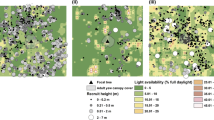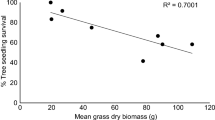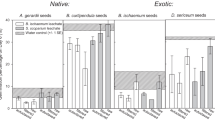Abstract
Field experiments were established to assess possible allelopathic suppression by Lantana camara L. of two indigenous tree species. The design allowed comparison of allelopathic effects with density-dependent resource competition effects. Fire and its role in competitive interactions was included as an experimental treatment. Allelopathic responses were measured in L. camara thickets by germinating and growing Alectryon subcinereus (A. Gray) Radlk. in dry rainforest ecotones (Macleay River) or Cryptocarya rigida (Meissner) in warm temperate rainforest and wet sclerophyll forest (Lake Macquarie) at 10, 20 and 30 seedlings m-2, where L. camara was either physically removed (LR), burnt (LB), or cut and left in place (LT). Germination for both species increased significantly by completely removing L. camara (LR) whereas burning (LB) was significant only for C. rigida. Seedling growth for both species was negatively related to increasing density when all L. camara was removed (LR) but was positively related in the other two treatments (LB and LT). C. rigida seedling biomass increased 47.4% (1.75%2.58 g) and 68.6% (1.98%2.95 g) with increasing seedling density for LT and LB respectively and decreased 23.2% (2.93–2.25 g) for LR. A. subcinereus seedling biomass increased 29.7% (1.95–2.53 g) and 34.7% (2.25–3.03 g) with increasing seedling density for LT and LB respectively and decreased 27.9% (3.30–2.38 g) for LR. Phytotoxin dilution effects were inferred in LT and LB rather than density-dependent intraspecific competition, whereas the reverse was true for LR. Seedling biomass for C. rigida resulting from potential phytotoxin dilution at high seedling density was not significantly different from the response of LR at low seedling density but, for A. subcinereus, the phytotoxin dilution response was significantly less than LR at low seedling density. Moderately intense fire (LB) was not significantly different from the LT treatment at both locations, emphasising that moderate to low intensity fires should not be used to control existing invasions of L. camara. Competitive strategies for invasive populations are identified that may modify succession following disturbance, thereby allowing thicket formation and long-term persistence to affect community dynamics. Such strategies need to be recognised in managing natural communities, particularly for biodiversity conservation.
Nomenclature: Harden (1990).
Similar content being viewed by others
References
Achhireddy, N. R. & Singh, M. 1984. Allelopathic effects of lantana (Lantana camara) on milkweed vine (Morrenia odorata). Weed Sci. 32: 757-761.
Adams, M. A., Iser, J., Kelleher, A. D. & Cheal, D. C. 1994. Nitrogen and phosphorus availability and the role of fire in the heathlands at Wilson's Promontory. Austr. J. Bot. 42: 269-281.
Bennett, R. J. 1989. Dry rainforest - fire interactions in the Apsley-Macleay gorges: implications formanagement. Master of Natural Resources Thesis, University of New England, Armidale.
Bewick, T. A., Shilling, D. G., Dusky, J. A. & Williams, D. 1994. Effects of celery (Apium graveolens) root residue on growth of various crops and weeds. Weed Techn. 8: 625-629.
Bhatt, Y. D., Rawat, Y. S. & Singh, S. P. 1994. Changes in ecosystem functioning after replacement of forest by Lantanashrubland in Kumaun Himalaya. J. Veg. Sci. 5: 67-70.
Burr, E. J. 1981. NEVA Users Manual: Analysis of Variance for Complete Factorial Experiments. University of New England, Armidale.
Chapin, F. S., Ultousek, P. M. & Van Cleve, K. 1986. The nature of nutrient limitation in plant communities. Amer. Nat. 127: 48-58.
Connell, J. H. 1983. On the prevalence and relative importance of interspecificcompetition: evidence fromfield experiments.Amer. Nat. 122: 661-696.
Dekker, J. H., Meggitt, W. F. & Putnam, A. R. 1983. Experimental methodologies to evaluate allelopathic plant interactions: the Abutilon theophrasti-Glycine maxmodel. J. Chem. Ecol. 9: 945- 981.
Diamond, J. M. 1983. Laboratory, field and natural experiments. Nature 304: 586-587.
Fensham, R. J., Fairfax, R. J. & Connell, R. J. 1994. The invasion of Lantana camaraL. in Forty Mile Scrub National Park, North Queensland. Austr. J. Ecol. 19: 297-305.
Firbank, L. G. & Watkinson, A. R. 1985. On the analysis of competition within two-species mixtures of plants. J. Appl. Ecol. 22: 503-517.
Fischer, N.H., Williamson, G. B., Weidenhamer, J.D. & Richardson, D. R. 1994. In search of allelopathy in the Florida scrub. The role of terpenoids. J. Chem. Ecol. 20: 1355-1380.
Floyd, A. G. 1989. Rainforest Trees of Mainland South-Eastern Australia. Inkata Press, Melbourne.
Fuerst, E. P. & Putnam, A. R. 1983. Separating the competitive and allelopathic components of interference: theoretical principles. J. Chem. Ecol. 9: 937-944.
Gallagher, S. 1979. The effect of Lantana camaraon its immediate environment. Unpublished report, New South Wales Institute of Technology, Sydney.
Gentle, C. B. & Duggin, J. A. 1997. Lantana camaraL. invasions in dry rainforest-open forest ecotones: the role of disturbances associated with fire and cattle grazing. Austr. J. Ecol. (in press).
Goldberg, D. E. & Werner, P. A. 1983. Equivalence of competitors in plant communities: a null hypothesis and a field experimental approach. Amer. J. Bot. 70: 1098-1104.
Grime, J. P. 1977. Evidence for the existence of three primary strategies in plants and its relevance to ecological and evolutionary theory. Amer. Nat. 111: 1169-1194.
Groves, R. H. 1991. Status of environmental weed control in Australia. Plant Protection Quarterly 6: 95-98.
Haddad, C. R. B. & Valio, I. F. M. 1993. Effect of fire on flowering of Lantana montevidensisBriq. J. Plant Phys. 141: 704-707.
Harden, G. (ed) 1990. Flora of New South Wales. Volumes 1-4. New South Wales University Press, Kensington.
Hardin, G. 1960. The competitive exclusion principle. Science 131: 1292-1297.
Hart, N. K., Lamberton, J. A., Sioumis, A. A. & Saures, H. 1976. New triterpenes of Lantana camara. A comparative study of the constituents of several taxa. Austr. J. Chem. 29: 655-671.
Hobbs, R. J. 1989. The nature and effects of disturbance relative to invasions. Pp. 389-405. In: Drake, J.A., Mooney, H. A., di Castri, F., Groves, R. H., Kruger, F. J., Rejmanek, M. & Williamson, M. (eds), Biological invasions - a global perspective. Scope 37 Wiley, Chichester.
Lamb, R. 1982. Some effects of Lantana camaraon community dynamics of eucalypt woodland. Proceedings of the 52nd ANZAAS Congress, Section 12: 304-305.
Langenheim, J. H. 1994. Higher plant terpenoids: A phytocentric overview of their ecological roles. J. Chem. Ecol. 20: 1223-1280.
Macdonald, I. A. W., Thebauld, G., Strahm, W. A. & Strasberg, D. 1991. Effects of alien plant invasions on native vegetation remnants on La Reunion (Mascarene Islands, Indian Ocean). Environ. Cons. 18: 51-61.
Mallik, A. V. & Roberts, B. A. 1994. Natural regeneration of Pinus resinosaon burned and unburned sites in Newfounland. J. Veg. Sci. 5: 179-186.
Mersie, W. & Singh, M. 1987. Allelopathic effect of Lantanaon some agronomic crops and weeds. Plant Soil 98: 25-30.
Miller, R. S. 1967. Pattern and process in competition. Adv. Ecol. Res. 4: 1-74.
Mount, A. B. 1969. Eucalypt ecology as related to fire. Proc. the Tall Timbers Fire Ecol. Conf. 9: 75-108.
Muller, C. H. 1965. The role of chemical inhibition (allelopathy) in vegetational composition. Bull. Torrey Bot. Club 93: 332-351.
Nilsson, M. C. 1994. Separation of allelopathy and resource competition by the boreal dwarf shrub Empetrum hermaphroditumHagerup. Oecologia 98: 1-7.
Pellissier, F. 1994. Effect of phenolic compounds in humus on the natural regeneration of spruce. Phytochemistry 36: 865-867.
Prasad, K. & Srivastava, V. C. 1991. Teletoxic effect of weeds on germination and growth of rice (Oryza sativa). Indian J. Agr. Sci. 61: 591-592.
Putnam, A. R. & Tang, C-S. 1986. Allelopathy: the state of the science. In: Putnam A. R. & Tang, C-S. (eds). The Science of Allelopathy. John Wiley and Sons, New York.
Raison, R. J. 1980. A review of the role of fire in nutrient cycling in Australian native forest, and of methodology for studying the fire-nutrient interaction. Austr. J. Ecology 5: 15-21.
Rawat, Y. S., Bhatt, Y. D., Punde, P. & Singh, S. P. 1994. Production and nutrient cycling in Arundinaria falcataand Lantana camara- the two converted ecosystems in central Himalaya. Tropical Ecol. 35: 53-67.
Reader, R. J. & Bricker, B. D. 1994. Barriers to the establishment of invading non-forest plants in deciduous forest nature reserves. Envir. Cons. 21: 62-66.
Rutherford, M. C. & Powrie, L. W. 1993. Allelochemic control of biomass allocation in interacting shrub species. J. Chem. Ecol. 19: 893-906.
Sahid, I. B. & Sagau, J. B. 1993. Allelopathic effect of Lantana (Lantana camara) and Siam weed (Chromolaena odorata) on selected crops. Weed Sci. 41: 303-308.
Schoener, T. W. 1983. Field experiments on interspecific competition. Amer. Nat. 122: 240-285.
Silander, J. A. & Antonovics, J. 1982. Analysis of interspecific interactions in a coastal plant community - a perturbation approach. Nature 298: 557-560.
Swarbrick, J. T., Willson, B. W. & Hannan-Jones, M. A. 1995. The biology of Australian weeds 25. Lantana camaraL. Plant Prot. Quart. 10: 82-95.
Thijs, J., Shann, J. R. & Weidenhamer, J. D. 1994. The effect of phytotoxins on competitive outcome in a model system. Ecology 75: 1959-1964.
Tilman, D. 1987. On the meaning of competition and the mechanisms of competitive superiority. Funct. Ecol. 1: 304-315.
Tilman, D. 1988. Plant strategies and the structure and dynamics of plant communities. Princeton University Press, Princeton, New Jersey.
Usher, M. B. 1988. Biological invasions of nature reserves: a search for generalisations. Biol. Cons. 44: 119-135.
Van Wilgen, B. W. & Richardson, D. M. 1985. The effects of alien shrub invasions on vegetation structure and fire behaviour in South African fynbos shrublands: a simulation study. J. Appl. Ecol. 22: 455-466.
Webb, L. J. 1968. Environmental relationships of the structural types of Australian rainforest vegetation. Ecology 49: 296-311.
Webb, L. J. 1978. A general classification of Australian rainforests. Austr. Plants 9: 349-363.
Weidenhamer, J. D., Hartnett, D. C. & Romeo, J. T. 1989. Density-dependent phytotoxicity: distinguishing resource competition and allelopathic interference in plants. J. Appl. Ecol. 26: 613-624.
Willis, R. J. 1985. The historical bases of the concepts of allelopathy. J. History Biol. 18: 71-102.
Wilson, J. B. 1988. Shoot competition and root competition. J. Appl. Ecol. 25: 279-296.
Wilson, S. D. & Keddy, P. A. 1986. Species competitive ability and position along a natural stress/disturbance gradient. Ecology 67: 1236-1242.
Author information
Authors and Affiliations
Rights and permissions
About this article
Cite this article
Gentle, C.B., Duggin*, J.A. Allelopathy as a competitive strategy in persistent thickets of Lantana camara L. in three Australian forest communities. Plant Ecology 132, 85–95 (1997). https://doi.org/10.1023/A:1009707404802
Issue Date:
DOI: https://doi.org/10.1023/A:1009707404802




